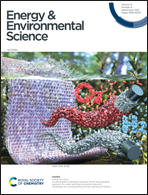An internal encapsulating layer for efficient, stable, repairable and low-lead-leakage perovskite solar cells†
Abstract
Perovskite solar cells (PSCs) have demonstrated remarkable progress, showing high power conversion efficiencies (PCEs) and low cost. However, there is still huge room for improvement in terms of long-term stability, repairability, and lead toxicity reduction before large-scale industrialization can start. Here, we propose an internal encapsulating layer (IEL) based on an in situ cross-linked insoluble polymer (Spiro-NPU) with matched energy levels, good electrical conductivity, and matched hole mobility. While the insertion of Spiro-NPU significantly enhanced the photovoltaic performance, with highest PCEs of 23.26% on a rigid substrate and about 20% for flexible devices, most importantly, the IEL strongly enhanced the moisture/thermal stability and repairability of the PSCs. No PCE decay was observed after 3000 h of aging in air at 60% relative humidity (RH); over 90% of the initial efficiency was maintained after 500 h of aging at 85% RH and 25 °C (or at 55% RH and 85 °C); and 97% of the initial PCE was retained after operating at the maximum power point (MPP) under 1 sun illumination (∼50 °C in N2) for 200 h without any external encapsulation. In addition, the photovoltaic-inactive hydrated phase of the perovskite film obtained after one month of aging (85% RH at 25 °C) can be recovered back into the photovoltaic-active black phase after annealing or irradiation at 1 sun, and the corresponding PSCs also show this repairability. Furthermore, our IEL exhibits lead blocking capabilities, paving the way to a promising strategy aimed at stable, efficient, and safe PSCs.



 Please wait while we load your content...
Please wait while we load your content...